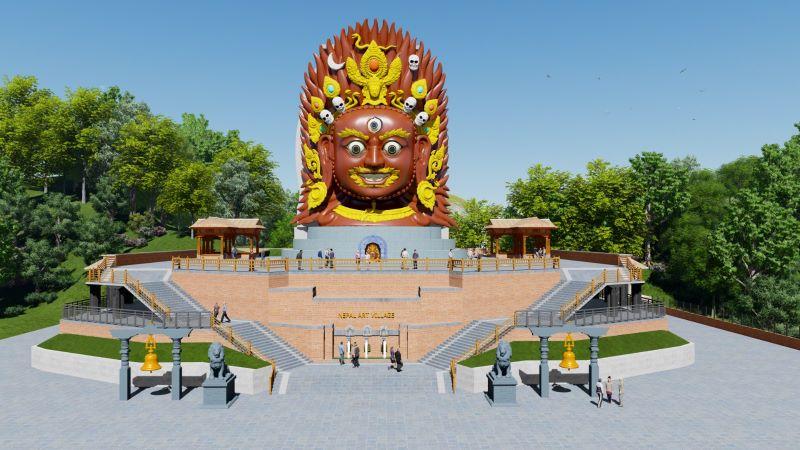The construction of the world’s largest Bhairab statue, known as ‘Nepal Art Village,’ has officially commenced in Champi, Godawari, Lalitpur. This monumental project aims to create a striking cultural landmark with a Bhairab statue crafted from panchadhatu (five metals) that will stand 72 feet tall, 58 feet wide, and weigh 65 tons.
According to Rupakman Maherjan, a founding member and spokesperson for the project, the Bhairab statue will be assembled using a five-story RCC building frame. The structure will house the Bhairab statue on the front side and an art museum within. Given its colossal size, the project is expected to be listed in the Guinness World Records.
The total area for the project spans 238 ropanis (approximately 12.4 hectares). The first phase includes the construction of the Bhairab statue and other heritage sites on 52 ropanis, while the remaining 186 ropanis will be developed into an art village.
Maherjan added that visitors will not only be able to view the statue but also explore detailed information related to Bhairab. The complex will feature 16 different Ganesh idols and 64 various Bhairab statues. At the statue’s 42-foot height, visitors will have a panoramic view of the Kathmandu Valley and the surrounding Himalayan ranges. Additionally, the site will offer dining options featuring local cuisines, meeting halls, and facilities for community events.
The project will include traditional structures such as temples, stone spouts, ponds, gardens, and various artistic exhibits. It will also have a stage, helipad, ancient settlements, old-age homes, wedding venues, yoga centers, banquet halls, tent camps, adventure sports, and a swimming pool. The aim is to develop and promote the area as a cultural and artistic city.
The construction was initially led by the late senior artist Rajkumar Shakya and is now under the guidance of his sons, Swarup and Saurabh Shakya, and their team. The project began in 2017 with land acquisition and was officially inaugurated in 2020, though progress slowed due to Shakya’s passing. The construction is now advancing rapidly, as reported by Rajendra Shakya, Chairman of Nepal Art Village Pvt. Ltd.
The project involves energetic artists, businesspeople, social entrepreneurs, and prominent figures. The management team includes Rajendra Shakya, Rajesh Awale, Rupakman Maherjan, Jeevan Ratna Shakya, Madan Man Maherjan, Urmila Shakya, and Sanuchhori Shakya. Their goal is to preserve and promote Nepali art and culture, enhance traditional skills, and boost tourism.
The site is accessible from various routes: a 10.5 km distance from Ekat Kun to Bhaisepati-Bungmati, 13 km from Ekat Kun to Chunikhel, and 15 km from Satdobato to Chapagao. Efforts are underway to improve road access and water supply, with budget allocations from both the central and provincial governments.
The project will include residential buildings designed in traditional Nepali architecture, offering both commercial and private accommodations. The commercial sector will adhere to company regulations, while traditional lodging will promote tourism.
An art village will be established to preserve traditional arts, crafts, and techniques. It will feature training centers for eight traditional craft forms, including metalwork and wood carving, with plans to expand to other Nepali craft traditions.
The project will also include a botanical garden dedicated to preserving endangered and useful plants. The center will focus on sustainable development, biodiversity conservation, and environmental education through workshops, seminars, and live laboratories for students.
Visitors will have the opportunity to explore nature trails, observe wildlife, and enjoy activities such as trekking, cycling, camping, and campfires. The area will be developed to enhance these experiences.
The Nepal Art Village is set to become a significant cultural and tourist destination, offering a unique blend of artistic, historical, and natural attractions.






